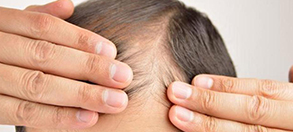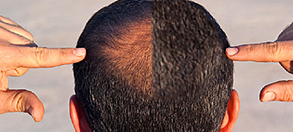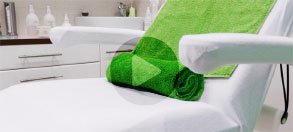
PDO threads are commonly used in aesthetic medicine and have now emerged as a popular solution for hair restoration, also known as thread embedding therapy (TET). These threads, made of biodegradable polydioxanone polymer (PDO), offer a non-surgical approach to addressing hair loss and promoting hair regrowth. Hair loss is a prevalent issue affecting an increasing number of people, and while it may not pose a threat to one’s physical health, its psychological impact should not be underestimated. Dealing with hair loss can cause significant distress, leading many people to seek effective solutions for hair restoration. In recent years, PDO threads have emerged as a popular option in the field of aesthetic medicine, offering a minimally-invasive approach to address hair loss and help individuals regain their confidence.
With a wealth of experience in the field of hair restoration, Dr. Goran Jezic is a highly regarded double-board-certified surgeon based in the Houston, TX, area. Over the past two decades, he has dedicated his expertise and skills to restoring the hair of countless individuals at his clinic, the Houston Hair Transplant Center. Dr. Jezic’s extensive knowledge and understanding of hair restoration make him a trusted professional in the field. He stays up to date with the latest advancements and techniques in the industry, ensuring that his patients receive the most effective and innovative treatments available. Learn more about PDO threads for hair restoration with Dr. Jezic by calling 713-864-2300 or requesting a consultation online. Then, keep up with groundbreaking treatments to combat hair loss on Dr. Jezic’s blog.
About PDO Threads for Hair Restoration in Houston
Scientists have been studying the science of hair loss for many years. Through their research, they concluded that we can lose around 100 hairs per day without issue. [1] But when the rate of hair loss exceeds this number without an equal amount of new hair growth, it can eventually result in visibly thinning hair.
PDO threads are a type of innovative medical device used in various aesthetic procedures, including hair restoration. PDO stands for polydioxanone, which is a biocompatible material commonly used in surgical sutures. These threads are thin, absorbable strands made from PDO material. The threads are strategically placed in the target areas of the scalp to stimulate hair growth and improve the overall appearance of the hair.
In one study, PDO threads used in hair restoration enhanced anagen induction, the active growth phase of the hair follicle. In comparison to a control group treated with normal saline, the groups treated with PDO threads exhibited the development of hair shafts through the epidermis, which suggests that PDO thread treatment, similar to minoxidil, promotes the progression of hair follicles to the mature anagen phase, stimulating hair growth. [2]
Does It Work?
Scientists used a special test called immunohistochemical analysis to learn more about how PDO threads help restore hair. They looked at markers called BrdU and PCNA. When they stained the hair follicles with BrdU, they saw a strong positive reaction in different parts like:
- The bulge – a region located within the upper part of the hair follicle that plays a crucial role in hair follicle regeneration and hair cycling.
- The inner and outer root sheaths – layers of cells that surround the hair shaft within the hair follicle that provide protection and support to the growing hair.
- The panniculus carnosus – a layer of muscle fibers found in certain mammals which, when studied, helped researchers gain insights into the effects of PDO threads on hair follicle activity.
In short: PDO thread treatment makes cells divide and grow. They also noticed that PDO threads help the cells in the hair bulb grow more, which supports hair growth and development. In fact, according to the same study, using PDO threads for hair restoration just once resulted in hair growth similar to that achieved by using minoxidil multiple times consecutively!
The Science Behind PDO Threads for Hair Restoration
The science behind how PDO threads work in hair restoration involves several mechanisms:
- When PDO threads are inserted into the scalp, they create a mesh-like structure that provides mechanical support to the existing hair follicles. This support helps to stabilize and strengthen the hair follicles, preventing further hair loss.
- PDO threads stimulate the production of collagen, a protein that provides structure and support to the skin and hair follicles. [3] The threads induce a controlled injury response in the treated area, triggering the body’s natural healing process. As a result, increased production of collagen occurs, which helps to improve the overall health and quality of the hair follicles.
- PDO threads also promote neovascularization, which is the formation of new blood vessels. [4] Improved blood circulation to the scalp enhances the delivery of oxygen, nutrients, and growth factors to the hair follicles. This increased blood flow can revitalize dormant follicles, stimulate hair growth, and improve the thickness and density of existing hair.
- PDO threads can activate and stimulate the cells within the hair follicles. They encourage cell division and proliferation, promoting the growth of new hair strands. This activation of dormant follicles and the stimulation of cellular activity contribute to the overall restoration of hair.
- Over time, PDO threads promote tissue remodeling within the skin, including the scalp. [5] The threads gradually dissolve, but their presence stimulates the body’s healing response and collagen remodeling. This remodeling process helps to create a supportive environment for healthy hair growth and can lead to long-lasting results.
What are the Benefits of PDO Threads for Hair Restoration?
The benefits of PDO threads are numerous. Patients can customize their treatment based on individual goals. The threads can be inserted at precise locations and angles, tailored to address specific areas of hair loss or thinning. This customization ensures that the treatment targets the areas of concern effectively.
Compared to surgical hair restoration procedures, PDO thread treatments typically involve minimal downtime. While some mild swelling or bruising may occur, it is generally temporary and subsides quickly. Patients can often resume their normal activities shortly after the procedure.
One of the unique advantages of PDO threads over other hair restoration methods is the ability to stimulate collagen production. While the threads gradually dissolve over time, their effects can continue for several months to a year or more. The stimulation of collagen production and tissue remodeling contribute to sustained improvements in hair density, thickness, and overall hair quality.
Ideal Candidates for PDO Threads for Hair Restoration
According to the International Society of Hair Restoration Surgery, approximately 35 million males and 21 million females in the United States are affected by hair loss. [6] The exciting news for these sufferers is that PDO threads can be beneficial for patients with different hair types, including straight, wavy, or curly hair. The treatment is not limited by hair texture or ethnicity, making it a versatile option for a wide range of patients in the Houston area seeking hair restoration.
Personal Consultation
As a doctor, Dr. Jezic finds the consultation process to be an enjoyable and valuable opportunity. It allows him to establish a connection with his patients, understand their unique hair restoration goals, and determine the most suitable treatment approach.
During this time, Dr. Jezic can gather important information about your medical history, assess your current hair condition, and discuss your expectations and desired outcomes. This personalized interaction enables Dr. Jezic to develop a comprehensive understanding of each patient, ensuring that the recommended treatment aligns with their goals and lifestyle. By fostering this open and collaborative dialogue, Dr. Jezic strives to provide the best possible care and achieve successful hair restoration outcomes for his patients. Whether PDO threads, FUE, or topical treatments, Dr. Jezic will suggest the path of least resistance to get your hair growing almost as fast as your confidence!
Preparation for PDO Threads
To prepare for your treatment, it is advised to refrain from consuming alcohol and smoking. Additionally, Dr. Jezic asks his patients to avoid certain medications and supplements in the 24 hours prior to treatment. These include Aspirin, Ibuprofen, Advil, some supplements, and non-steroidal anti-inflammatory drugs (NSAIDs). This precaution minimizes bruising and bleeding in the treatment area.
The PDO Threads for Hair Restoration Procedure
Local anesthesia is administered to ensure the patient’s comfort during the procedure. This numbs the treatment area and reduces any potential discomfort. Then, Dr. Jezic takes the thin, dissolvable PDO threads and carefully inserted them into the scalp using a fine needle or cannula. The threads are strategically placed using Dr. Jezic’s advanced anatomical knowledge and experience with the procedure.
Recovery After PDO Threads
Immediately after the procedure, some mild swelling, redness, or tenderness in the treated areas may be experienced. These effects are generally temporary and should subside within a few days.
Avoid applying excessive pressure or manipulation to the treated areas, especially when washing the hair, during the initial recovery phase. This helps to ensure that the threads remain in their intended positions and allows for optimal healing.
Furthermore, strenuous activities, intense workouts, and heavy lifting should be avoided for a certain period as recommended by Dr. Jezic. It is essential to allow the scalp to heal without unnecessary strain or pressure. The Houston Hair Transplant Center Team will provide a comprehensive guide to recovering from your PDO threads procedure.
What are the Results of PDO Threads for Hair Restoration?
One study revealed a significant distinction in hair mass index (HMI) or hair count between a PDO treatment group and a placebo group. Most of the individuals who received the PDO treatment (73.3%) reported substantial improvements in various aspects associated with hair loss, including
- The rate of hair loss
- Hair thickness
- Ease of managing or styling their hair
Furthermore, a higher percentage of those in the treatment group (76.8%) expressed that their hair felt coarser and thicker after undergoing the treatment. [7]
What is the Cost of PDO Threads for Hair Restoration in Houston?
To obtain accurate and up-to-date pricing information, it is recommended to contact the Houston Hair Restoration Clinic scheduling coordinator in Houston directly at 713-864-2300. They will be able to provide you with detailed information about the cost of PDO threads for hair restoration and any additional fees associated with the procedure. Schedule a consultation with Dr. Jezic to discuss your specific needs and receive a personalized quote based on your unique circumstances. We look forward to seeing you!
References
- Martínez-Velasco MA, Vázquez-Herrera NE, Maddy AJ, Asz-Sigall D, Tosti A. The Hair Shedding Visual Scale: A Quick Tool to Assess Hair Loss in Women. Dermatology and Therapy. 2017;7(1):155-165. https://doi.org/10.1007/s13555-017-0171-8
- Seo HS, Jeong HS, Shin HJ, et al. The Success of Thread-embedding Therapy in Generating Hair Re-growth in Mice Points to Its Possibly Having a Similar Effect in Humans. Journal of Pharmacopuncture. 2015;18(4):20-25. https://doi.org/10.3831/kpi.2015.18.033
- Cho SW, Shin BH, Heo CY, Shim JH. Efficacy study of the new polycaprolactone thread compared with other commercialized threads in a murine model. Journal of Cosmetic Dermatology. 2021;20(9):2743-2749. https://doi.org/10.1111/jocd.13883
- Lots TCC. Effect of pdo facelift threads on facial skin tissues: An ultrasonographic analysis. Journal of Cosmetic Dermatology. Published online May 2, 2023. https://doi.org/10.1111/jocd.15761
- Arora S, Arora G. Neck rejuvenation with thread lift. Journal of Cutaneous and Aesthetic Surgery. 2019;12(3):196. https://doi.org/10.4103/jcas.jcas_181_18
- International Society of Hair Restoration Surgery. 2022 Practice Census Results.; 2022. Accessed May 25, 2023. https://ishrs.org/wp-content/uploads/2022/04/Report-2022-ISHRS-Practice-Census_04-19-22-FINAL.pdf
- Metwalli M, Khattab FM, Mandour S. Monofilament threads in treatment of female hair loss. Journal of Dermatological Treatment. 2020;32(5):521-525. https://doi.org/10.1080/09546634.2019.1682499


